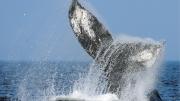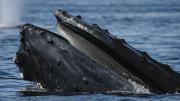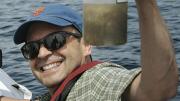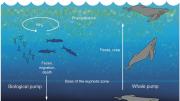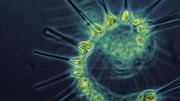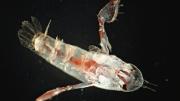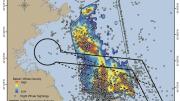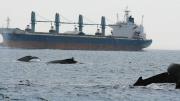Among the environmental-protection and natural-resources laws enacted in the United States during the 1970s, the Endangered Species Act (1973) suffers from a uniquely bad reputation. Why should the mighty Tennessee Valley Authority’s Tellico Dam be held up by a nondescript fish called the snail darter? What self-interested North Carolina landowner wouldn’t clear-cut longleaf pines after learning that red-cockaded woodpecker habitat might be rendered undevelopable? In such cases, where tangible rewards appear to conflict with protecting species that have no known economic constituency (often, indeed, creatures no one has even heard of before), conservation doesn’t count for much.
Joe Roman ’85, who earned his Ph.D. in organismic and evolutionary biology in 2003 (with a master’s in wildlife ecology and conservation from the University of Florida in between), set himself the task of visiting the scene of some of America’s most heated, and revealing, endangered-species controversies. An advocate, he has nonetheless crafted sympathetic portraits of the issues at stake, while making the case for the value of nature and of species protection. The result is his second book, Listed: Dispatches from America’s Endangered Species Act (to be published in May by Harvard University Press). In this excerpt that draws on his own research, he presents a surprising discovery about the vital role whales (some species endangered, others not) play in maintaining the biological productivity of their ocean habitats.
Unlike snail darters, of course, whales are reasonably familiar and well known, even beyond their past economic significance (and controversies over continued hunting). That Roman, now at the Gund Institute for Ecological Economics at the University of Vermont, could make such a basic finding about these popular mammals suggests what may be at stake throughout nature for the thousands of other endangered species that are studied scarcely, if at all.
~The Editors
I stood on the bow of the Nereid, a 27-foot research vessel, as it crossed the Bay of Fundy. There were no whales in sight on the choppy sea, one of the last known feeding grounds of the endangered North Atlantic right whale. The late-summer sun lifted slowly over Nova Scotia. My mind started to wander: what would the bay have been like 500 years ago, before commercial whaling began? Hundreds of rights were probably feeding on copepods, minute planktonic crustaceans, leaving their bushy V-shaped blows at the surface. There would have been finbacks, humpbacks, minkes—and maybe, just maybe, an occasional gray. The disappearance of the gray whale from the Atlantic remains a mystery. Was it hunted to extinction? Had it already disappeared before humans took to the sea with lances and harpoons?
There was a slick on the chop, and then the enormous head of the first right whale broke through. Right whales are incredibly buoyant; that they floated after death made them more attractive to whalers—made them the “right” whale to kill and now among the most endangered. Some rose with their rostrums covered in mud from a deep foraging dive in search of large patches of zooplankton. Before they fluked, a few mud-brown logs were released at the surface: whale turds. They floated out of view.
A couple of months later, when I started my master’s degree at the University of Florida, I read that grizzlies played a role in dispersing marine nutrients into the forests surrounding salmon streams. When the fish returned to their natal streams to spawn, most died, releasing nitrogen into the waterways and thus to riverine plants and trees. Bears preyed on them and then spread the nutrients even farther when they defecated and peed. About a sixth of all the nitrogen found in spruce trees surrounding salmon streams comes from the sea; bears release the great majority of it.
That night, an idea floated up through the beery haze of a biker bar, where my master’s adviser held informal lab meetings late into the night. What about those whales diving for energy-rich crustaceans, then rising from the depths to breathe, and poop?
The classic story in the ocean is one of sinking. In many areas of the Gulf of Maine, nitrogen levels at the surface are so low in the summer that they approach zero, limiting the growth of phytoplankton. Copepods and other zooplankton often feed on algae along the surface at night, then migrate down the water column to escape predators by day. When they go deep, the ammonia they excrete takes nitrogen away from the surface. Their fecal pellets sink. Their own deaths take nitrogen, phosphorus, carbon, and iron away from the surface layer, reducing primary productivity. As it is too dark at the bottom for phytoplankton to grow, the nutrients are considered lost. This pattern is known as the biological pump, as if all living beings contribute only to a downward flow.
But watch a whale long enough, and you’ll see a different pattern. Many whales feed at depth and poop at the surface. (In case you were wondering, right whales often produce brown or red logs, which float at the surface before breaking up. Humpbacks and many other fish-eating whales tend to release broad plumes.) Their upward movement is obligatory—they have to come to the surface to breathe. By releasing nutrients there, they could be creating a whale pump. But did they transfer enough nitrogen to make a difference? Jim McCarthy, professor of biological oceanography and co-adviser on my Ph.D. committee at Harvard, suggested that we look at all the air-breathing vertebrates in the Gulf of Maine. Our work showed that whales, along with seals and seabirds, transfer thousands of tons of nitrogen to the surface in areas where they feed: they are, in a sense, fertilizing their own garden, bringing more nitrogen into the gulf than all rivers in the region combined do.
A few researchers welcomed the idea. Marine mammalogist Sam Ridgway and a colleague had written in the 1980s that cetaceans could lift nutrients from deep waters, in a process that resembled oceanographic upwelling. He told me that when he had watched dolphins from an underwater acrylic chamber in the Pacific their feces came out and disappeared “in a cloud within a very few meters and very few seconds.” The nutrients appeared to be released immediately, close to the surface.
Others resisted the concept, suggesting that large-bodied and relatively rare animals couldn’t have much impact on ocean productivity. And there were major policy implications: as marine mammals have recovered from being overhunted, some countries have insisted that whales and other predators should be culled to reduce competition with human fisheries. This position is championed by the Japanese government, in part to justify its “scientific” whaling program and resume commercial whaling: If whales eat “our” fish, the thought goes, then killing them is an efficient way to protect fisheries and harvest some high-priced kujira, or whale meat, in the process. Several recent studies have shown that marine mammals have a negligible effect on fisheries. And the whale pump hypothesis suggested that cetaceans actually increased productivity in areas where they feed. The relationship between whales and their prey was far more complicated than whalers would have you believe.
One of our reviewers had had a good point: there were feeding aggregations of whales not far from the lab at Harvard where we had done some analyses—why hadn’t we gone out there and tested our hypothesis? I e-mailed Mason Weinrich, who has studied humpbacks off the coast of Massachusetts for years, asking if he had any humpback poop available. Within a few minutes, he replied: “I have several samples sitting on my desk, actually—preserved in alcohol—and we carry a ‘pooper scooper’ net with us wherever we go.” When did I need them?
Great. But the trouble with analyzing ammonium is that you really need fresh feces. How quickly does the dung break down? How long does it stay at the surface? Do phytoplankton use it? I’d have to go to sea to find out. After a few months of discussions, Dave Wiley, a whale biologist and research coordinator on Stellwagen Bank off the coast of Massachusetts, offered me a berth on a 187-foot research vessel. As chief scientist on a project to learn everything about humpback whales—Where do they feed? What do they eat? How much time do they spend in busy, risky shipping lanes?—he thought our nutrient work, while admittedly quirky, would complement his team’s research. One of the great joys of science has to be turning a thought that surfaced one night over a few beers into a full-blown field project.
In July, I boarded the Nancy Foster on its first leg, up from Woods Hole to Stellwagen Bank, an underwater plateau north of Cape Cod, where every summer several hundred humpbacks come to feed. Also aboard the ship were a group of scientists, two whale observers, and a crew of 22.
On the horizon, a container ship made its way into Boston Harbor. For years, the shipping channel had gone through the productive feeding grounds of humpbacks and right whales, putting dozens of them at risk of being run over. For years, Wiley and his colleagues had collected data, showing the shipping patterns and where and when the whales fed. The ships passed right through some of the densest feeding areas for whales and seabirds. Rather than bringing his work to a government agency, Wiley took his charts and graphs directly to the shipping companies. “We showed them that by moving the channel slightly to the north,” Wiley said, “we could avoid potential collisions.” It was a straightforward argument—it wouldn’t cost all that much in fuel or time. With the shippers on board, it was easy to persuade the Coast Guard and other federal agencies to support the idea; the International Maritime Organization confirmed the move, and the lane was shifted in 2007. Whale collisions have decreased.
Off the stern, a huge vertical spout rose, deep as a foghorn, then glints of stainless steel flashed off a slate-blue flank that arched above the water: a finback, large and fast—more streamlined than the humpbacks—passed like a racehorse, ending with a relatively tiny dorsal fin, the mammal so big that even the time it had taken to surface had seemed enormous.
Near the horizon, a humpback breached, twisting 360 degrees. A calf began to lob tail, moving its dark fluke in the air. Humpbacks are the splashy ones, playful, interactive. To Melville they were “the most gamesome and light-hearted of all the whales, making more gay foam and white water generally than any of them.” To at least one biologist, they were cute but exhausting, like three-year-olds or puppies. “They’re always like, ‘Look at me. Look at me.’”
And then there were the right whales, the first cetacean I had got to know, rare and brooding, plying the waters with an enormous scowl and a train wreck of cornified skin covered in whale lice—callosities. They had already left for the more productive deep waters of the Bay of Fundy by the time we arrived on Stellwagen. These surly Goths of the North Atlantic had recently been dubbed the urban whale—they feed near Boston and raise their offspring off Jacksonville, Florida, one of the busiest ports in the country. One biologist has likened it to raising your kids on the interstate: to the enormous 800-foot ships in the region, these 40-foot whales were little more than possums to an eighteen-wheeler. Right whales, greatly reduced by overharvesting a hundred years ago, have been protected since the 1930s—but until recently, only against intentional hunts.
As Michael Moore of Woods Hole Oceanographic Institution, who has done more than his share of whale necropsies, likes to say, the United States is still one of the biggest whaling nations on Earth—but we do it through negligence, with ships and commercial fishing gear, rather than with harpoons. When caught in a net or line, humpbacks relax and let a team get to work, but right whales, Moore has discovered, need sedation. Both whale species are subject to the same risks, but humpbacks have rebounded to more than 10,000 in the North Atlantic, with estimated growth rates of more than 3 percent a year. For a large-bodied, long-lived species, that was quite good, testament to the success of the moratorium on commercial whaling put into place in 1986.
As we floated over Stellwagen Bank, Boston nothing more than a callosity on the horizon, suddenly there was a spout of coral, then rust. Up ahead, a whale rose, arching her back and kicking with her flukes. Somebody called out, “Poop!” It was as big as our Zodiac, a plume of weak green tea. This cloud of unknowing descended several meters down the water column. I eased a plankton net through the plume and captured a bit in the cod end, stowing it in a cooler.
I had worried that, collecting and processing fetid fecal samples, I would get seasick aboard the Nancy Foster, which rolled, if not exactly like a well-greased pig, then like one in clover. But humpback feces came up roses compared to that of right whales. Roz Rolland, a senior scientist at the New England Aquarium, has used the samples to check lipid levels, revealing the nutritional status of each whale; to test for protozoan parasites; to assay hormone levels, which reveal sexual maturity, pregnancy, and stress; and to measure biotoxins found in harmful algal blooms—paralytic shellfish poisoning may be curbing the whale’s ability to recover from centuries of exploitation.…
Dave Wiley didn’t start at Stellwagen. His first offshore assignment after graduating from the University of Massachusetts was as a marine-mammal observer—off Dumpsite 106. Back then, New York City and New Jersey shipped their sewage 12 miles offshore, dumping an average of eight million tons each year on the continental shelf. Bacterial levels rose. Heavy metals contaminated the seafloor. Were the dolphins and other whales in the area affected? There weren’t many in the area, but Wiley had learned something critical to my analysis: the sludge sat above the thermocline, the border between the nutrient-rich bottom waters and the light-filled upper surface, exactly as I suspected whale poop did. Whale feces could enhance biological activity— but the millions of tons of concentrated and contaminated human sludge created a hypoxic environment, a “dead zone,” where oxygen levels were so low, many fish and invertebrates couldn’t survive. Shellfish beds were closed. Fisheries were closed. New York City finally stopped dumping its sewage there in 1992, but around the world, dead zones are still growing, caused in many cases by the runoff of excess fertilizer. The discharge from the Mississippi River has created a hypoxic area that at times grows as large as New Jersey.
Away from these dead zones, the upper layer of many coastal systems becomes nitrogen depleted as the growing season proceeds. In the spring, plankton bloom as temperatures warm, and a boundary layer is formed between the cold, nutrient-rich waters and the upper surface. Only in this upper layer—the euphotic zone—is there enough light for photosynthesis. There, phytoplankton, the base of the marine food web, grow until they use up much of the nitrogen, iron, or other essential nutrients.
Meanwhile, the cold dense water nearer to the bottom remains rich in these nutrients. Here’s where the whale pump comes into play: after this boundary layer has formed, many cetaceans actively feed at the bottom, rising to the surface to breathe—and poop.…
Back in the ship’s wet lab, my fears of seasickness proved unfounded. The humpback specimens smelled mostly of brine; there was the slightest bit of ash—some sand lance scales and bones—at the bottom of the liter jar. I filtered the fecal samples and added reagents to measure the nitrogen in the plumes: the darker they turned, the higher the concentration of ammonium. I ran the spec—ammonium levels were through the roof for those that were deepest blue. Although the ambient levels approached zero, the water from the fecal plume had a concentration of more than 30 micromoles: the humpbacks were releasing plumes of nitrogen more highly concentrated than the rich bottom waters where they fed. Here was our first field evidence that whales were fertilizing their gardens.
Just as trees had become more than board feet or timber, whales were far more than the number of barrels inscribed in a logbook or the number of pounds of kujira or hvalkjøtt on the market. Whales could increase primary productivity in the gulf, helping to sustain fisheries and even, perhaps, fight climate change by pumping iron, a limiting nutrient, to the surface of the southern oceans. Despite attempts to show that whales were our competitors—they eat our fish, therefore they should be caught—it looked as if, in fact, more whales meant greater productivity and more fish. Just increasing the standing stock of whales could help, their massive bodies sequestering carbon after they died, like fluking forests in the seas.
Maybe it is better to watch whales than to eat them.…
